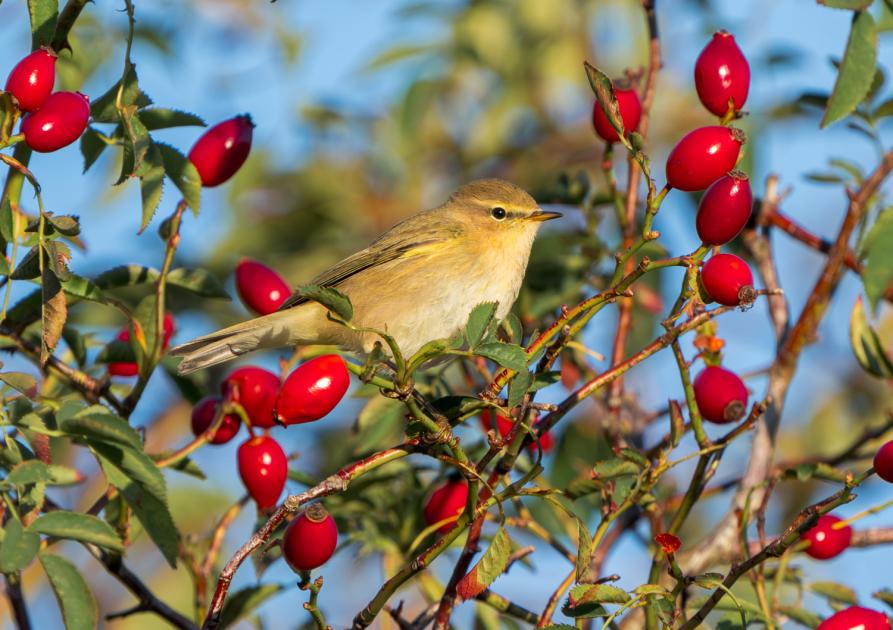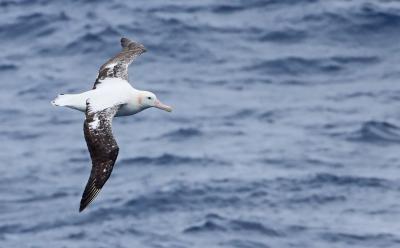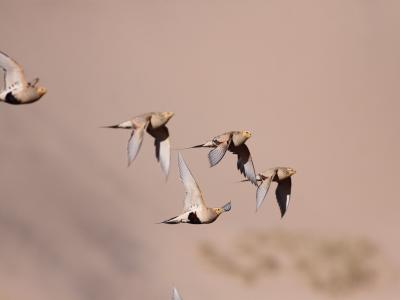Sweden: Fall Migration at Falsterbo
-
Sep 20-27, 2026
Stephen Menzie
-
Sep 12-19, 2027
Stephen Menzie
2026
Single Room Supplement $670
2027
2027 Tour Price to be Determined
2026
Single Room Supplement $670
2027
2027 Tour Price to be Determined
The Scandinavian Peninsula is a vast region rich in birdlife. Every autumn, countless millions of breeding birds empty out of the northern forests and fells for southern climes. Located at the very tip of this landmass, Falsterbo acts like a very narrow delivery end of an enormous funnel. Consequently, it has long been regarded as one of Europe’s premier birding sites, and indeed the flight of birds there is one of the great natural spectacles on the planet. With migration already well underway in July, beginning with species on long-distance journeys to the equator or beyond, and continuing practically unabated through November, it is difficult to recommend a time to visit Falsterbo. Our tour aims for a transition period between movements of a diverse host of African migrants, including shorebirds, flycatchers, pipits, and warblers, and the staggering later-season flights of doves, finches, corvids, tits, and thrushes bound for continental Europe. This is also an excellent time for raptors, for which Falsterbo is arguably the best site in all of Europe. When the conditions are right, the sky is an ever-shifting gallery of kites, hawks, and falcons. And there is a good chance for rarities as well – just as Falsterbo funnels Northern Europe’s breeding birds, it is also bottleneck for any stray that might have wandered into the region.
We’ll keep a close eye on the weather (which is very often glorious and autumnal) and plan our days accordingly. Much of the migration takes place overhead, and we may spend an entire morning in one location, waiting to see what passes by and over us. Portable seats as well as tea and coffee will keep us going through the morning. If conditions seem safe to leave, we’ll venture short distances off the Falsterbo peninsula to search for sparse local breeders like Black Woodpecker and Bearded Reedling, and visit good locations for shorebirds, gulls, and terns, always to return to our home base in the hamlet of Skanör (the sister-town to Falsterbo), and to lodgings in a beautiful historic inn. With excellent food, a gorgeous setting, a strong community of local birders, and world-class birding at a relaxed pace, Falsterbo is the place for anyone wishing to increase their experience with European birds, or, perhaps, simply with the wonders of bird migration.
Day 1: Our tour begins this morning in Denmark at Copenhagen’s Kastrup airport. Once gathered, we’ll head across the Øresund Bridge to Sweden. It’s about a 45-minute drive to the Falsterbo peninsula, where we’ll check into our cozy hotel in Skanör (the small town 5-minutes' drive north of Falsterbo). Once we’re settled in, we’ll have a short introductory meeting before talking a walk to some nearby wetlands or pastures. Depending on what’s been migrating that morning, these areas can be good for wildfowl, shorebirds, pipits, wagtails, finches, and perhaps some raptors. Night in Skanör.
Days 2-6: From our home base in the village, all the wonders of the Falsterbo-Skanör peninsula will be within easy reach. Our daily itinerary will hinge on the weather and the magnitude of bird migration. Most mornings we’ll be out at first light near the famous Falsterbo Bird Observatory lighthouse gardens. On days of heavy migration, the sky can be filled with an unceasing passage of wagtails, pipits, finches, corvids, doves, and, as the morning increases, raptors. One of the long-lasting memories of Falsterbo will be seeing a sky full of birds on a good morning, and the experience is as much about the sight and sound of tens-of-thousands of birds in flight overhead as it is about the variety of species. Because Stephen’s day job is Observatory Manager, we’ll also be able to gain unique access to the banding in the lighthouse garden, giving us the chance to see many of the migrants up close and personal, as well as taking a look at the important scientific work that the observatory does.
Our mornings at the point will allow us to assess the day’s migration and determine how we’ll spend the rest of the day. When the weather is right, the birds keep coming, and we’ll want to spend as much time as we can birding the gardens, marshes, and meadows (as well as the golf course!) around the point on the hunt for any birds that have chosen to land, while always keeping an eye to the sky where the bulk of the action remains. We’ll also take pleasant walks through a forested area which opens up to rolling sand dunes and a large heath. Here, when the raptors are on the move, one can sit down and watch a stream of Eurasian Sparrowhawks, Red Kites, Eurasian Kestrels, Eurasian Hobbies, and Common and European Honey Buzzards, all the while noting warblers, tits, and other songbirds flitting through the birches and pines. Lunch will be taken in a nearby restaurant – several of which have terraces and outdoor eating areas, so keep your coats on as we will be eating al fresco. On previous trips, lunch-time sightings have included White Stork, Black Kite and White-tailed Eagle.
While it is the prospect of staying put and letting the birds come to us which is the great appeal of spending a week at Falsterbo in the height of fall migration, we’ll take some time to visit local areas of interest off the peninsula. One such is Lomma Bay, just north of Malmö, which can be excellent for gulls and shorebirds, while the nearby campus of Alnarp, with its many plantings and some very old oaks, is often good for migrants as well as resident woodland birds. We’ll also visit Lake Krankesjön, where we’ll hope to find species not typically present at Falsterbo, including Common Crane, Bearded Reedling, and perhaps Crested Tit if we’re lucky. Other times we may venture along the southern coastline in search of shorebirds, terns, and gulls. And, with a strong community of birders in the area, we’ll stay updated as to what is being seen, and will be prepared to go in search of any rarities that may turn up in the region.
Regardless of whether we remain at Falsterbo or venture farther afield, our days promise to be filled with first-rate birding, fresh air, good meals, optional downtime, and minimal time on the road. All nights in Skanör.
Day 7: After morning birding, we’ll make our way towards Malmö, Sweden, across the straight from the Kastrup airport in Copenhagen, sometime after lunch. Depending on how we’ve fared, we may do some birding in somewhere along the way. Night in Malmö.
Day 8: The tour concludes this morning with transfers to Copenhagen’s Kastrup airport.
Note: The information presented here is an abbreviated version of our formal General Information for Tours to Sweden. Its purpose is solely to give readers a sense of what might be involved if they took this tour. Although we do our best to make sure what follows here is completely accurate, it should not be used as a replacement for the formal document which will be sent to all tour registrants, and whose contents supersedes any information contained here.
ENTERING AND LEAVING DENMARK AND SWEDEN: The regulations for both countries are the same: a passport valid for at least three month after the conclusion of your stay and with at least two blank pages for entry stamps. Visas are not required for stays of under 90 days. Citizens of other countries should contact their nearest Danish and Swedish consulates or embassies for the rules applicable to them.
COUNTRY INFORMATION: You can review the U.S. Department of State Country Specific Travel Information here: https://travel.state.gov/content/travel.html and the CIA World Factbook here: https://www.cia.gov/the-world-factbook/. Review foreign travel advice from the UK government here: https://www.gov.uk/foreign-travel-advice and travel advice and advisories from the Government of Canada here: https://travel.gc.ca/travelling/advisories.
PACE OF THE TOUR: This is a fairly relaxed tour. Breakfast will be between 7.00 and 8.00am, allowing us plenty of time to arrive at the prime spots soon afterwards. Lunch will usually consist of either a picnic in a scenic area or a casual sit-down at a local restaurant. We will return to the hotel in time to freshen up for dinner at one of several excellent restaurants in the area.
Virtually all the walking is fairly easy on good paths or trails. Most of the birdwatching is done within a short distance of our vehicle. In fact, at Falsterbo, one of the main routes of the migrating birds is directly over the car park and adjacent bird observatory wood. With the variable weather conditions the birdwatching itinerary will be decided on a daily basis by the leader.
HEALTH: The Centers for Disease Control and Prevention (CDC) recommends that all travelers be up to date on routine vaccinations. These include measles-mumps-rubella (MMR) vaccine, diphtheria-tetanus-pertussis vaccine, varicella (chickenpox) vaccine, polio vaccine, and your yearly flu shot.
The most current information about travelers’ health recommendations can be found on the CDC’s Travel Health website here: https://wwwnc.cdc.gov/travel/destinations/list
Smoking: Smoking and vaping are prohibited in the vehicles or when the group is gathered for meals, checklists, etc. If you are sharing a room with a nonsmoker, please do not smoke in the room. If you smoke in the field, do so well away and downwind from the group. If any location where the group is gathered has a stricter policy than the WINGS policy, that stricter policy will prevail.
CLIMATE: Temperatures will typically range from 10°C (about 50°F) in the morning to a maximum of 18°C (65°F) at midday, although it can be (or feel…) colder if overcast and windy, and warmer temperatures are likewise possible. The average rainfall in September is 60mm (2.36 in) and showers are always a possibility.
ACCOMMODATION: Our small hotel is located in the quaint village of Skanor, just to the north of Falsterbo, and within walking distance of the sea and prime birding areas. The rooms are typical of this kind of hotel being simple and not too large but very clean and have adjustable heating to suit individual needs. All rooms have a bathroom with shower facilities, and towels are provided. The last night of the tour will be in Malmo, Sweden, a 15-minute train ride from the airport in Copenhagen, to facilitate departures on the last day.
Internet Access: Our hotels have wireless internet access. There is no laundry service at the hotel but a 24-hour laundry service can be arranged with the tour leader. The cost is calculated by weight and is around $4 per pound, though there is a 6-pound minimum.
FOOD: Modern Swedish cuisine is generally accessible, diverse, and excellent. Opportunities will be had as well to explore some classic Scandinavian dishes. Since there are only a few establishments open at Falsterbo out of season, we are likely to eat in some of the restaurants on more than one occasion.
Food Allergies / Requirements: We cannot guarantee that all food allergies can be accommodated at every destination. Participants with significant food allergies or special dietary requirements should bring appropriate foods with them for those times when their needs cannot be met. Announced meal times are always approximate depending on how the day unfolds. Participants who need to eat according to a fixed schedule should bring supplemental food. Please contact the WINGS office if you have any questions.
TRANSPORTATION: Our transportation will be by mini-bus driven by the leader. We will rotate the seating each day.
Interactive Map
2024 Narrative
It was another successful fall trip to Falsterbo, one of Europe’s foremost migration hotspots. A variety of migrants were seen, including raptors, such as Red Kite, Common and Honey Buzzard, Eurasian Hobby and a Lesser Spotted Eagle; wildfowl of all of the expected species, plus a surprise Red-breasted Goose; and passerines, including hundreds of Common Chaffinches and Meadow Pipits, as well as a host of warblers and other small birds that were caught by the observatory for banding. Away from the migration-watching points, we found species like White Stork, Crested Tit and Tawny Owl, as well as taking some time to explore the local culture, such as a visit to a Viking fort and inside a 13th-century church.
IN FULL
Day 1: Saturday 21st September
After convening at Copenhagen airport on the afternoon of September 21st, the group headed across the Öresund Bridge from Denmark into Sweden. Our first destination was the south-coast town of Trelleborg, where we stopped at a small boating lake. Here, we took a couple of hours to familiarise ourselves with some of Sweden’s commoner avifauna. A single Common Redshank was on the boating lake, along with a Black-headed Gull, several (European) Herring Gulls and multiple Eurasian (Green-winged) Teals. On the sea, rafts of Eurasian Coots were joined by a handful of Red-breasted Mergansers, while in the nearby bushes we found Common Chiffchaffs, Reed Buntings and Eurasian Tree Sparrows. Overhead, a Eurasian Sparrowhawk passed by, as did a Common Kestrel and an all-too-brief Merlin. A walk along the shoreline added several new species to our list including a Common Sandpiper and two subtle scarcities: a Rock Pipit and a Caspian Gull.
Next up was an impromptu visit to Falsterbo Park, where a Red-breasted Flycatcher had been found. After some waiting, the bird showed itself, perfectly framed through a narrow gap in the trees. Being a young bird, it was lacking the red breast, unlike the two red-breasted European Robins that shared the tree with the flycatcher, along with a Goldcrest and a Blue Tit.
From there, it was a short drive to our hotel, where we enjoyed a dinner of meatballs and a dessert of ice cream and cloudberries – a truly Swedish meal!
Day 2: Sunday 22nd September
After a good night’s sleep and a hearty Scandinavian breakfast, we headed to Flommen, one of Falsterbo Bird Observatory’s banding sites. The banders had just returned from a net round, and we were treated to up close and personal views of a Reed Warbler, a Common Chiffchaff, a Wren, a Dunnock and a beautiful Sedge Warbler, as well as taking a look at the finer details of separating male from female Reed Buntings.
Overhead, there was a good passage of Chaffinches and Meadow Pipits, although many of the birds were staying high. One Meadow Pipit did decided to land on the roof of one of the beach huts, though, where it gave excellent views. There was also a reasonable of raptors; mostly Common Buzzards, but also several Red Kites, Eurasian Sparrowhawks, Common Kestrels and a Eurasian Hobby.
Moving on, we stopped to admire some White Wagtails on the golf-course driving range and a Little Grebe on the nearby pond before heading to Knösen, at the far north-end of the peninsula. There, we found a flock of Barnacle Geese – small, smart, black-and-white geese – and a handful of Northern Wheatears, and we marvelled at the spectacle of a flock of European Golden Plovers that was several thousand birds strong.
After a delicious lunch – a Chilean-Swedish fusion – we settled down at the Heath for a couple of hours of raptor-watching. We couldn’t have timed it better; not long into our vigil, an eagle appeared: Lesser Spotted! Remarkably, up to five of these usually scarce birds have been seen in southern Sweden in recent months – three had already migrated to Denmark, but this bird was one of two known to still be in Sweden. Still, it was a fortuitous find as recorded are typically less than annual in Sweden. Just a few scope-views further along from the Lesser Spotteds, we found two more eagles: a pair of White-tailed. These, plus the dozens of Common Kestrels, a showy Marsh Harrier and some Red Admiral butterflies sipping sap from the birch trees made for a memorable visit to one of southern Sweden’s most famous birding hotspots.
We finished the day with a walk across the boardwalk the runs out from Skanör’s church. Here, we located double-figures of Greenshank as well as four Spotted Redwing, dozens of Common Snipe, four Dunlin and a Eurasian Curlew. As the sun got lower in the sky, we enjoyed watching the locals making use of the pristine beaches before we headed back to the hotel for checklist and dinner.
Day 3: Monday 23rd September
Monday dawned still and sunny, and we headed north, off the peninsula to our first stop at Klagshamn. Here, we took a short walk to the ‘bird tower’, which overlooks the bay and a series of reedy pools. Multiple Grey Herons were adorning the boulders that are strewn across the bay, while a large flock of Golden Plovers was high in the sky in the distance and a Marsh Harrier was hunting over the reed bed. Some movement caught our eye on the edge of the pool below the tower: a Water Rail! Elusive at first, after a short wait the bird emerged into the open – and was joined by a second bird! Both individuals of this normally secretive species (typically heard but seldom seen) showed incredibly well as they moved along the edge of the reeds and even crossed the open water from one side of the pool to the other. On our way out from the site, we stopped as an old limestone quarry, now flooded and home to several pairs of Great Crested Grebes.
Next, we continued our journey north, passing along the coast through Malmö. We stopped briefly at the city’s Öresund Park, where we enjoyed close views of half a dozen Common Moorhens, including three juveniles that were tempted out into the open by a fallen apple.
From here, we drove to the north end of the city, to Spillepen. Large number of gulls gather in the bay north of here and, amogst them, we found several Caspian Gulls. It was the goose flock that held the real prize, though – scanning through the Greylag and Barnacle Geese, we happened upon a Red-breasted Goose. Wow! Surely the world’s most attractive goose, and a rare bird in Sweden. Indeed, it was the first time we have seen the species on the WINGS Fall at Falsterbo tour.
For lunch, we headed to the Swedish Agricultural University’s campus at Alnarp, which is conveniently located within striking distance of our next target species – Firecrest, A short walk from the café, we found a pair of birds, which eventually showed themselves in a dense Yew tree.
Our final stop of the day was the extensive, sandy bay at Lomma. Here, we found multiple species of shorebirds, including Eurasian Oystercatcher, Bar-tailed Godwit and Dunlin. There was a large flock of Eurasian Wigeon, as well as Northern Pintails and Eurasian (Green-winged) Teals, and a flock of 30 Eurasian Tree Sparrows was moving between nearby gardens and the weedy area along the tideline.
We heard back to the hotel a little early today, since we would be continuing the birding after dinner. Following a delicious meal in a local Indian restaurant, we headed out to Falsterbo park where we were able to locate the bird we were looking for: a Tawny Owl, which flew into the trees above us and gave great views by torchlight.
Day 4: Tuesday 24th September
Our first port of call was Falsterbo lighthouse, where we were able to see more of the observatory’s banding activity – a Common Chiffchaff, a pair of Blackcaps (the female having a brown cap), and a Song Thrush were amongst the birds caught by the banders that morning. Just before we left to head to Nabben, we struck lucky: the banders had just caught a Wood Warbler, a species seldom seen this late in the season.
At Nabben – Falsterbo’s southernmost point – we enjoyed the spectacle of migration, with waves of hundreds of Common Chaffinches heading south overhead, as well as many Meadow Pipits and a few Tree Pipits. A large flock of White Wagtails were feeding on the small sandy island in the lagoon, where shorebirds included at least 20 Avocets. Migrating raptors were represented by a Western Marsh Harrier, a Merlin, a Hobby and several Kestrels. Despite the rain showers, it was an excellent morning, topped off by a view from the top of the lighthouse for those who wanted to brave the spiral staircase.
In the afternoon, we headed inland to the area around Skurup. Here, we found plenty of Red Kites and Marsh Harriers, as well as a large flock of Linnets. On Näsbyholm lake, we found masses of Greylag Geese and Northern Lapwings, while wildfowl comprised Northern Shovelers, Mallards, Gadwall, Teal, Pochard, Tufted Duck and Common Goldeneyes. A single Grey Wagtail flew over, and a White-tailed Eagle tried its luck with the geese, spooking most of the lake in the process.
A stop at the small wetland at Grönalund added Ruff to our trip list, while our final stop of the day, just a couple of miles up the road, saw us catching up with two Yellowhammers, one of which showed superbly on top of a high hedge.
Day 5: Wednesday 25th September
The weather turned today, with rain forecast and strong winds already blowing in the morning. To avoid the worst of the weather, we headed inland to the Vomb area. At our first stop, we managed to locate a singing Coal Tit, which remained uncharacteristically settled for long enough for us all to enjoy a view. A little further along the forest tracks, we found a small puddle that was attracting a host of little birds: three Grey Wagtails were on the track as we arrived, while two Common Treecreepers, two Marsh Tits, Blue Tits, Great Tits, Goldcrests and Chaffinches all came in to bathe.
At nearby Krankesjön, we found some Great White Egrets and an Osprey just before the heavens opened. Thankfully, the site comes equipped with a sheltered picnic area, and we were able to enjoy our lunch in relative comfort.
After lunch, we headed to the old royal stables and stud farm at Flyinge. This is the centre of Sweden’s breeding White Stork population – although, with no reports of storks anywhere in Sweden for over a week, we were concerned that they might have migrated already. A search of the historical site appeared to confirm that until, as were walking back to the car, ten storks flew over us! They landed on the stable roofs and gave excellent views.
Day 6: Thursday 26th September
Sustained 25 mph winds and squally showers meant today was a day best spent close to cover. We did our best to stay dry as we seawatched from the van at Smygehuk – Sweden’s most southerly point – and we were rewarded with an impressive flight of several thousand Brants, as well as a handful of Common Eiders and Common Scoters. Nonetheless, we were all relieved when the local café opened its tour and we could all head inside to dry off a little and enjoy a chai latte and a slice of cake.
The record of the day turned into something of a Swedish cultural experience – first, with a visit to the Viking fort at Trelleborg, including an educational tour of the fort’s museum; then, after lunch, some of the group visited Falsterbo church, the oldest parts of which date back to the 13th Century.
Day 7: Friday 27th September
It was another windy day at Falsterbo, and we tried our luck for the first few hours of that day at the lighthouse. The banding had been cancelled due to the 30 mph winds, but there were still some birds attempting to migrate: mostly Meadow Pipits, which, flying into the wind, passed by low and slowly, some even landing on the golf course, where they were joined by a couple of dozen White Wagtails and, new for our trip list, a single Yellow Wagtail. Chaffinches, too, were in evident as small flocked flew over, and a couple of Sparrowhawks whizzed through.
In a first for this tour, we took a short break to enjoy a bottle of Champagne (driver excluded!) and a slice of Princess Cake (a classic Swedish cake with sponge, cream and marzipan); then, we headed north into Malmö where we enjoyed an Italian lunch followed by a walking tour of the city (and, of course, a little birding in the city parks).
Finally, it was time to check into our hotel at Hyllie for the final night – and, of course, for our final checklist, where the group voted for their bird of the trip. Red-breasted Goose, White Stork, Tawny Owl and Water Rail all scored highlight – but it was the impressive flock of Golden Plovers that stole the show, with the sight and sound of the thousands of birds etched firmly in everyone’s mind.
-Stephen Menzie
Stephen was a delight, he gave us the insider's view of bird banding and migration at Falsterbo. In addition, he provided a running commentary on an outsider's perspective on life in Sweden. We ate at fantastic restaurants, learned a lot about Viking history, stopped at a Viking museum and rune stone.
- Dana L. on Sweden: Fall Migration at Falsterbo
My first tour with Wings! It was so enjoyable! Staying at one location is always something that makes a tour more relaxed and easy. It is a part of the world I had zero expectations for, and I was so pleasantly surprised. Everything was wonderful, and we saw many birds but also just had a fantastic time.
- Tara O. on Sweden: Fall Migration at Falsterbo
Maximum group size seven with one leader or nine with two leaders.




















